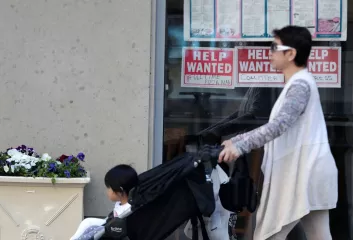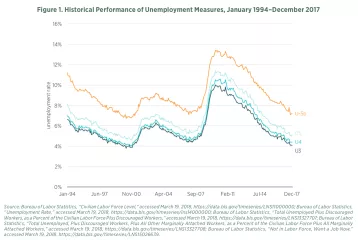- | Government Spending Government Spending
- | Expert Commentary Expert Commentary
- |
Jobs Report Shows Women Leading Growth in Labor Force
Editor's note: This post has been updated since its original publication
The Bureau of Labor Statistics (BLS) released the national jobs statistics for last month this morning, providing an updated picture of the health of the labor market.
The Bottom Line
After a strong jobs report for May, the June jobs numbers continued the longest-running jobs expansion in US history, adding 213,000 jobs. Meanwhile, the additional data allowed the employment estimates for March and April to be revised upward by a combined 37,000 jobs.
A deeper look into the data reveals that the labor force growth is entirely due to women joining the labor market—women (those 20 years old and over) increased their labor force participation by 646,000, while men (20 years old and over) saw a 119,000 decrease. The growth in women’s labor force participation is a significant departure from the relatively stable trend over the last few months.
Growth in teenager labor force participation reflected the disproportionate trend toward women joining the labor force, with women accounting for 75 percent (56,000) of the total 74,000 increase in the labor force.
It appears that this surge in women’s labor force participation is broadly comparable with the disparity in women’s college graduation rates. Last month, Mark Perry at American Enterprise Institute brought attention to US Deptartment of Education data, which indicates women will receive 663,000 more college degrees than men in 2018. It’s possible that the surge in women’s labor force participation reflects the effect of May’s college graduations and the corresponding proportionally larger number of women entering to the labor market afterward.
However, it would be somewhat surprising for this large of an effect to show up in the BLS seasonally-adjusted data, since the adjustment is done specifically to account for this kind of regularized change (and indeed, the seasonally-adjusted data doesn’t show a regular trend of labor force participation increases in May-July each year). But the non-seasonally adjusted labor force participation of all women from ages 20 through 24 does show this kind of surging growth in May and June each year, as well as that of bachelor-degree recipients in this age range. It’s possible that the labor force participation numbers will be revised downward in later months as the seasonal adjustment is better calibrated.
Unemployment
In light of the employment increase, it’s somewhat surprising that unemployment rose by 0.2 percentage points to 4.0 percent. The increase is primarily driven by rising labor force participation—601,000 new workers, which more than counteracts the slight shrinkage the labor force saw over the last few months. The growth implies that a group of new workers—predominantly women—has started actively looking for work rather than waiting on the sidelines.
Despite the uptick in unemployment, the May jobs openings data showed that for the first time ever there were more jobs available than workers actively seeking employment—a first in the history of labor market data collection. This may well have motivated the re-emergence of workers who had previously left the labor market (indeed, the data suggests that the number of reentrants to the job market increased by 204,000).
Meanwhile, the number of long-term unemployed workers increased substantially, which is a departure from the previous trend of steady decreases in long-term unemployment.
The silver lining to this somewhat mixed cloud of a jobs report is that the number of workers who are involuntarily working part-time—those who would prefer to work full-time instead—continued its long-trend decline, dropping by 205,000.
Wages
Wage growth over the previous 12 months held steady at 2.7 percent. Given the low unemployment rate and steady employment growth of around 200,000 jobs per month, the lack of strong wage growth has many economists puzzled. One explanation might be that previous regimes of strong wage growth occurred in environments of higher inflation (due to rising energy prices during the 1970s, for example) or higher productivity growth (in the period after World War 2 before the period of high inflation starting in the 1970s), neither of which is present currently.
However, many pundits over-focus on the growth in average wages across all jobs. Looking at specific industries provides a better understanding of the labor market and what’s going on beneath the surface. For example, average wage growth in the leisure and hospitality industry was 3.3 percent, average construction wage growth was 3.5 percent, and average retail wage growth was 3.8 percent. This suggests that wages in lower-skill jobs are increasing the fastest, which many people would argue is a good thing for low-income workers.
Headline Employment Statistics
- Total nonfarm payroll employment increased by 213,000 jobs.
- The labor force participation rate increased to 62.9 percent (601,000 new job seekers).
- The headline unemployment rate (U-3) increased by 0.2 percent to 4.0 percent.
Unemployment Statistics
- The mid- to long-term unemployment rate (15 weeks or longer; U-1) edged back up to 1.4 percent.
- The discouraged worker unemployment rate (U-4) increased 0.3 percent to 4.3 percent.
- The comprehensive jobless rate (U-5b) increased by 0.4 percentage points to 7.1 percent; an increase of 75,000 workers who say they want a job but aren’t actively seeking employment or currently available to take a job.
- Combined with the increase in the active labor force, this means the total number of active job seekers and passive job- seekers increased by 676,000.
- The comprehensive jobless rate offers a benchmark to compare the official unemployment statistics reported by the BLS, and includes everyone who says they want a job, regardless of their current availability to start employment or how long it has been since they have actively looked for work
Deeper Unemployment Statistics
- Long-term unemployed workers (27 weeks or longer) increased by 289,000 to 1,478,000; this means that proportion of long-term unemployed workers increased to 23.0 percent of those who are unemployed. This is a bit of a surprise, given the general decline in long-term unemployment.
- The number of people who wanted to work full time, but who could only find part-time work for economic reasons (because of slack work/unfavorable business conditions/inability to find full-time work) fell by 205,000 to 4,743,000, which was 18.2 percent of all part-time workers.
- The number of part-time workers who were part-time because they couldn’t find full time work fell by 33,000 to 1,447,000—just 30.5 percent of people who work part-time because of economic reasons.
More Wages Data
- Average hourly earnings increased by 2.7 percent over the previous 12 months. However, this aggregate estimate disguises the fact that:
- Average hourly earnings in leisure and hospitality jobs increased by 3.3 percent
- Average hourly earnings in construction jobs increased by 3.5 percent
- Average hourly earnings in retail trade jobs increased by 3.8 percent
- Average weekly hours worked held steady at 34.5 hours.
Photo credit: Lynne Sladky/AP/Shutterstock


